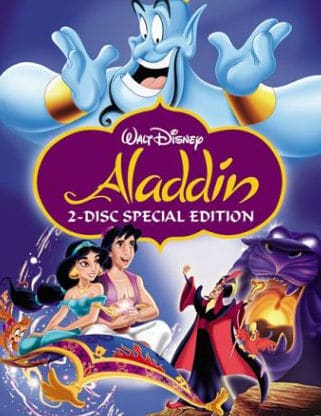
Welcome to Revisiting Disney! Today, we are looking at the story that swept us off our feet to a whole new world, Aladdin! Like always, I have labeled each category so if you want to skip to the parts that interest you most, feel free. And, of course, if you have any thoughts, burning or otherwise, please share in the comments!
BACKGROUND OF ALADDIN
Aladdin was released on November 25th, 1992, and was written and directed by Ron Clements and John Musker, who had brought us The Little Mermaid in 1989. Like other Disney films of this new wave, Aladdin was nominated for several awards. At the Golden Globes in 1993, Aladdin won Best Original Score-Motion Picture, Best Original Song for “A Whole New World,” and Robin Williams was given a special award “For His Vocal Work.” The film was also nominated for Best Motion Picture-Comedy or Musical, and the songs “Prince Ali” and “Friend Like Me” were also nominated.
At the Academy Awards that same year, Aladdin took home the Oscar for Best Music, Original Score, Best Music, Original Song for “A Whole New World,” and Best Sound. It was also nominated for Best Effects, Sound Effects Editing, and Best Music, Original Song for “Friend Like Me.” Overall, Aladdin won 26 awards and was nominated an additional 17 times.
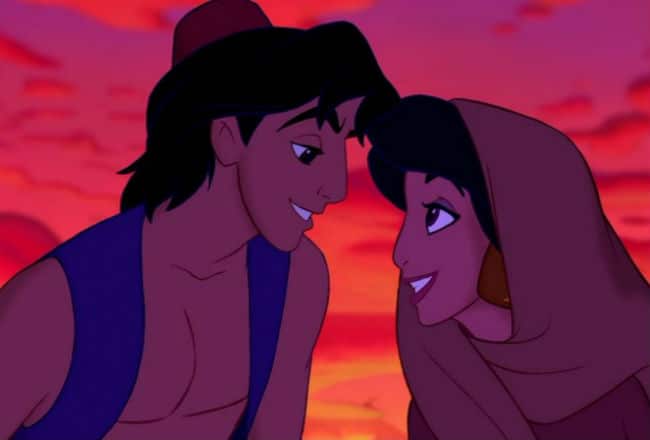
Photo: Disney
Despite the fact that it won so many awards, and that most of us probably remember Aladdin very fondly from our childhoods, Aladdin was faced with several roadblocks on the way to success. Originally, the story looked very different, with Aladdin being younger, having human friends, a living mother, and unlimited wishes.
During a viewing of the storyboard, however, it became clear that no one was particularly thrilled with how it was all coming together. On a day that the crew describes as “Black Friday,” they were given eight days to rework the story, with no changes to the release date of the film. Of course, they rose to the challenge admirably, and the result is the film we know and love today.
Work on Aladdin started in 1989, and like I said above, there were several things that changed as production went on. One thing that stayed pretty consistent, however, was the desire to have Robin Williams voice the Genie; the script was written with Williams in mind. Eric Goldberg, who was the lead animator on Genie, had drawn a sample reel of Genie, using an old recording of Williams doing standup comedy. When Williams saw it, he was onboard to be part of the project.
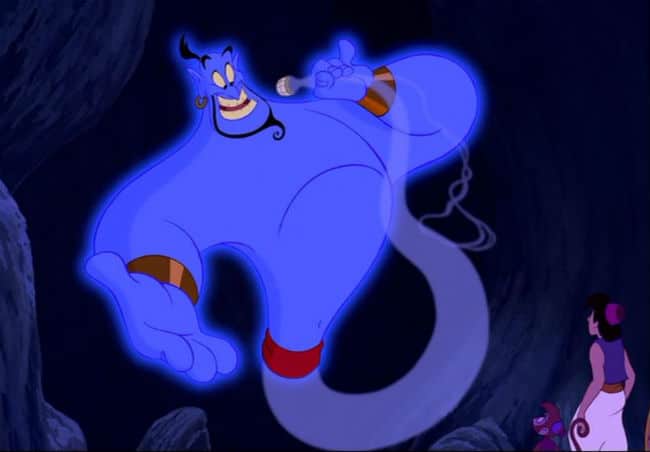
Photo: Disney
As the Genie, Robin Williams recorded the script but also improvised quite a bit as he read. Then Goldberg, Musker, and Clements would pick the bits that they thought would work best in the film.
However, there is a bit of a controversy with Aladdin. This is that Robin Williams agreed to voice the Genie and was paid very little. It seems that he agreed to work for less because the part was fun, and he asked that because of this, Genie be a small part of advertising, a request that was granted (on paper).
Unfortunately, this arrangement was broken, and Robin Williams distanced himself from the film and the Studio. In The Return of Jafar and the much beloved (to me, at least) 1994 “Aladdin” television show, Dan Castellaneta voiced the Genie. Disney eventually offered a public apology and their gestures of goodwill and apology convinced Williams to come back for the final Aladdin movie, Aladdin and the King of Thieves.
MUSIC
When the original story for Aladdin was written, Howard Ashman and Alan Menken had written a series of songs to fit that original mood. However, when Aladdin’s mother and friends were cut, so were their songs; when Jasmine because less of a spoiled character, her song that highlighted her spoiled character, “Call Me a Princess,” was cut.
After Howard Ashman’s death, lyricist Tim Rice was brought in to work with Alan Menken on the remainder of the songs for the film. Although the new music works wonderfully, I can imagine that it must have been hard for everyone involved, to have a new person step into the very large shoes of Howard Ashman.
Like I said above, though, Aladdin won Best Original Score-Motion Picture, and Best Original Song for “A Whole New World” at the 1993 Golden Globes, and the songs “Prince Ali” and “Friend Like Me” were also nominated. Broadway star Lea Salonga provided the singing voice for Jasmine, with Brad Kane working as the singing voice of Aladdin.
At the Academy Awards that same year, Aladdin took home the Oscar for Best Music, Original Score, and Best Music, Original Song for “A Whole New World,” and was nominated for Best Music, Original Song for “Friend Like Me.” The music in Aladdin is catchy and fun, and as seems to be the general case with Alan Menken, he is able to weave the music from the songs into the score. It’s subtle, but a nice touch.
And honestly, some of these songs will be in your heads for days, just by reading their titles. That’s strong songwriting right there.
ANIMATION
Like in Beauty and the Beast and The Rescuers Down Under, Aladdin took advantage of the new Computer Generated Imagery technology. With CGI having advanced even farther since its use in both those earlier films, there are even more CGI sequences, most notably during the scene where Aladdin and Abu are fleeing the Cave of Wonders.
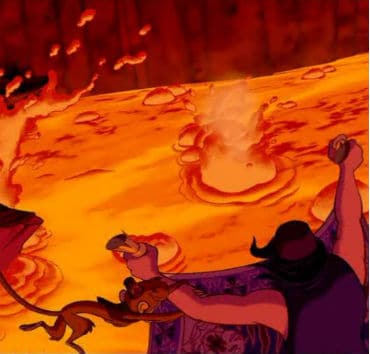
Photo: Disney
Originally, the plan had been to make Carpet an entirely CGI character, but animators in the “Making Of” feature remember that the carpet kept looking like it was CGI; it wasn’t integrating well into the overall look of the film, so they changed their minds on that point.
Andreas Deja, lead animator on Jafar, talks to Bob Thomas about his design, mentioning that he had animated Jafar in a way that “underplayed his (Jafar’s) emotions and went for subtle animation,” which contrasted with Eric Goldberg’s over-the-top animation of the Genie, used specifically to capture the essence and hilarity of Robin William’s performance (Thomas 1992:135).
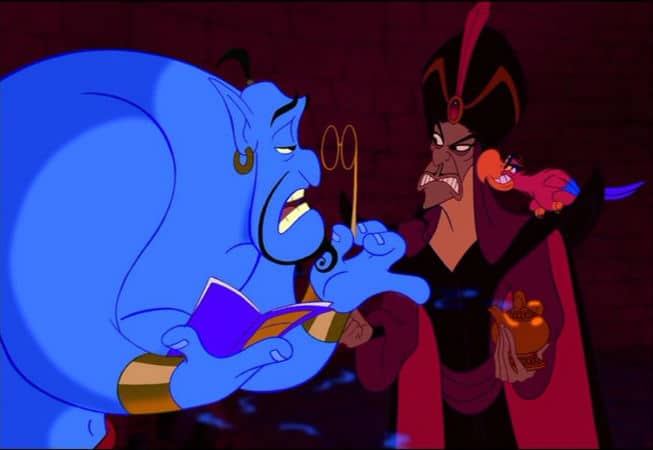
Photo: Disney
Like with other films, the backgrounds are critical to the overall success of the story. The backgrounds are rich, and were designed by a team lead by Richard Vander Wende and Bill Perkins. The team used vivid colors, like they had in the older classics, which makes the backgrounds pop a bit more (without distracting from the characters), and used what Thomas calls “highly stylized Persian miniatures and Arabian calligraphy” to create the backgrounds and feel of the film (Thomas 1992: 135).
THE PLOT
Aladdin starts off with the frame story of a merchant, telling us the story of things being more than what they seem when selling his wares. He introduces us to the villainous Jafar, who is using a thief to gain control of this lamp the merchant is trying to sell us. The lamp is inside the Cave of Wonders, guarded by its entrance, the tiger head guy. I don’t know how it works, but it looks cool.

Photo: Disney
The Cave tells Jafar and Company that only one person can enter the Cave and take the lamp, someone who is a diamond in the rough. Encouraging the thief that, yeah, he’s a diamond in the rough, Jafar shoos the poor guy into the Cave. The Tiger is less impressed, however, and the poor guy dies when the Cave collapses on him.
Jafar and his parrot Iago realize that they have to find the right diamond in the rough to get them the lamp. Cut to Aladdin, a poor thief who just wants some bread. He and his pet monkey Abu finally outruns the guards who are chasing them, only to be confronted with two starving children. Proving that they are the good guys, they give up their hard-stolen bread.

Photo: Abu
Riding through the city at that time is Prince Achmed, who is going to court the lovely Princess Jasmine. When a little boy runs out into the street and scares the horse, Achmed prepares to whip him. Aladdin intervenes, and though the kid get away unhurt, Aladdin is humiliated. Going home, he dreams of how he wishes his life was different.
Back at the palace, it turns out that Princess Jasmine was unimpressed with the Prince, and her pet tiger torn his pants, humiliating him (which seems fitting to me). The Sultan reminds his headstrong daughter that she has to marry a prince in the next three days, and she points out that she’s never been able to live her life the way she wants to.
Deciding that she needs to live her own life, Jasmine runs away. However, having never been outside the palace, she is not prepared for the idea of money and inadvertently steals an apple from a vendor for a starving kid. Luckily, Aladdin saw her earlier (and is enchanted), so steps in to save the day, as the vendor is about to cut off her hand for stealing.

Photo: Disney
They get away, and realize that they both feel trapped in their respective lives, though Aladdin’s “no food” thing seems a bit more serious than “I feel smothered by my wealth” (though to be honest, Jasmine does have some serious problems. I just love the look on Aladdin’s face when Jasmine mentions her problems).
Meanwhile, Jafar has used his powers of hypnosis to convince the Sultan to give him a diamond that will allow Jafar to find the diamond in the rough, who turns out to be Aladdin. Given directions to Aladdin’s home by Jafar, the guards find him and Jasmine there.
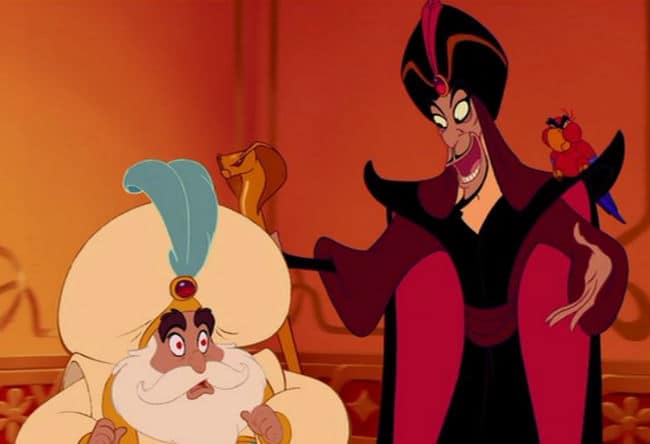
Photo: Disney
Being found by the guards, both Jasmine and Aladdin think they’ve been caught. Although they try to get away, it doesn’t work. With the guards taking Aladdin away to prison, Jasmine reveals herself as the princess to save him.
Finding out that Aladdin was taken on Jafar’s orders, Jasmine go to talk to him and arrange Aladdin’s release since he saved her life. Jafar points out that this street rat kidnapped the princess, to which Jasmine retorts that she ran away. Appearing to be contrite, Jafar informers her that Aladdin has already been beheaded. Jasmine is crushed, and an intervention with her father is required before she’ll be in the same room as Jafar.
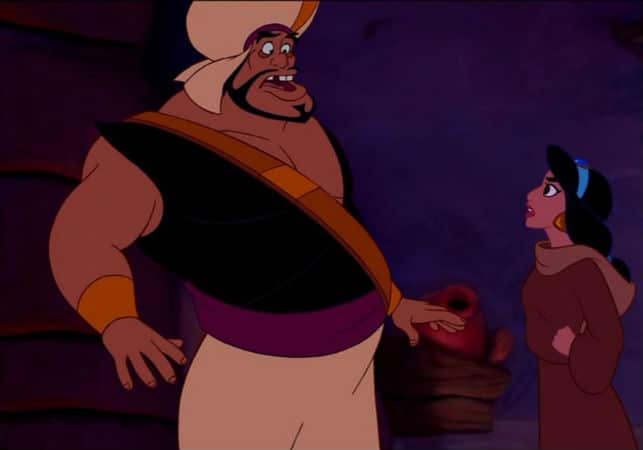
Photo: Disney
Of course, Aladdin has not been beheaded, as Jafar needs Aladdin to go into the Cave of Wonders to get the lamp. He was in prison realizing that he had been flirting with the princess, and was feeling a bit embarrassed about that. Abu comes to save him, and as they’re thinking of how to escape, they find an old man.
This is Jafar in disguise, and he takes Aladdin to the Cave of Wonders. The Cave lets Aladdin enter but warns him to not touch anything but the lamp. Aladdin has a hard time convincing Abu to follow the rules, but with the help of their new friend Carpet, they make it to the lamp.
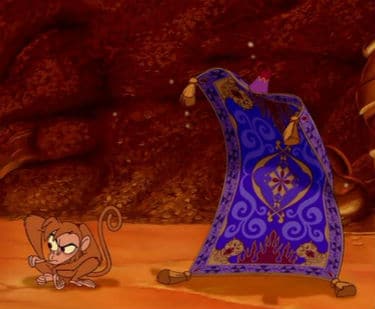
Photo: Disney
While Aladdin is getting the lamp, however, Abu finally succumbs to the lure of the treasure. This causes the Cave to become angry, and everything inside turns to molten lava. With the help of Carpet, the dynamic duo makes it to the entrance. The old man tells Aladdin that he will help him out after he hands him the lamp. When Aladdin does so, however, the old man tries to kill him. Abu intervenes and saves his friend, stealing the lamp back in the process.
Despite that, our heroes are still trapped in the cave. Wondering what was so awesome about the lamp, they rub it, only to find out that Aladdin now has three wishes when the Genie appears and begins the rollicking number “Friend Like Me.” Our dynamic duo trick the Genie into getting them out of the Cave, and when Aladdin admits that he’s in love with the Princess, he wishes to be a prince. He also promises to use his third wish to free the Genie.
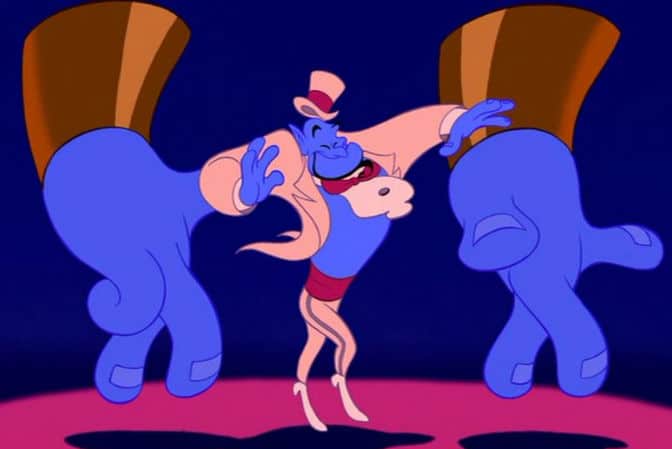
Photo: Disney
Unfortunately, although his princely behavior impresses the Sultan, Jafar is not amused. He had, you see, convinced the Sultan that Jasmine should marry Jafar if a prince was unavailable, a plan for power that this Prince Ali was messing up. Jasmine was also unimpressed with her new suitor, finding him arrogant and rude while still missing the boy from the market.
When the Genie tells him to be himself, Aladdin takes Jasmine on a magic carpet ride and, when he does act like himself, she actually likes him. Then, she recognizes him and is furious that he lied to her about who he really was. To keep from revealing that he actually wasn’t a prince, he tells her that sometimes he goes out in the streets in disguise but really is a prince. She believes him, and the magic carpet ride was, by all accounts, a success.
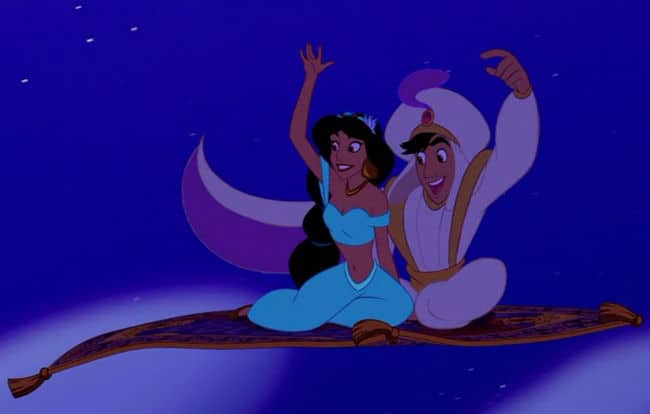
Photo: Disney
However, Jafar is still smarting and sends the guards to tie up Ali/Aladdin and drop him off a cliff. Luckily, the lamp goes down with him and he is able to rub it and use his second wish, to be saved.
The next day, when Jafar makes his move to marry Jasmine, Aladdin reappears (not dead!) and realizes that the Sultan has been being hypnotized for who knows how long. He breaks the spell and agrees to marry Jasmine. Exiled from the palace, Jafar realizes that Ali is Aladdin, who has the lamp, and sends Iago to retrieve it.
Meanwhile, Aladdin and the Genie are having a bit of a conflict, because Aladdin just realized that by marrying the princess he would someday be a Sultan, something he doesn’t know if he can do without Genie. Genie is understandably hurt, and retorts that Aladdin’s lied to everyone else, why not him too?
When Aladdin is being presented as Jasmine’s future husband, Jafar uses his first wish to become the Sultan. When that doesn’t go as planned, he uses his second wish to become a powerful sorcerer. He reveals Aladdin’s secret, sends him and Abu off to the Arctic in a tower, and enslaves everyone else.
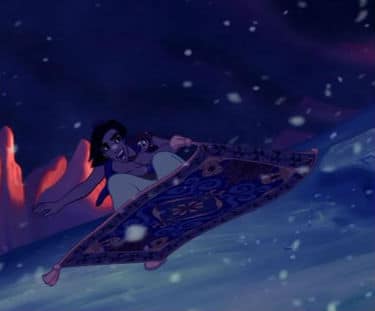
Photo: Disney
Aladdin realizes that he let everyone down and should have just been honest, as well as free the Genie when he could. Luckily, Carpet has come with them to the Artic, and, in a stunning piece of animation, is freed from being trapped under the tower. The three go back home and try to figure out a way to get the lamp back.
Jafar decides that he still wants to marry Jasmine, and decides to use his final wish to make her fall in love with him. However, that’s not something Genie can do. As they’re arguing, Jasmine sees Aladdin and decides to play along, distracting Jafar and Iago. However, Jafar sees Aladdin’s reflection in Jasmine’s crown before Aladdin can get the lamp, and begins to wreck havoc. Carpet is unraveled, Jasmine is trapped in an hourglass, and Abu is turned into a toy monkey.
Aladdin and Jafar fight in what is a cautionary tale for taunting the most powerful sorcerer in the world. Aladdin looks like he’s lost (Jafar is a giant snake by now) until he remembers something Genie told him; genies are slaves to their lamps.

Photo: Disney
Mentioning the power of being a genie to Jafar, Jafar falls for it hook, line, and sinker, using his third wish to become a genie. This traps him in a lamp and reverses all of his previous magic like Aladdin knew it would. Genie flicks the lamp (with Jafar and Iago inside it) to the Cave of Wonders, where it will hopefully stay for a long time (but that’s another story).
In the end, Aladdin realizes that he can’t pretend to be someone else, and even though he still loves Jasmine, he can’t use his third wish to become a prince. Instead, he frees Genie, who heads off on an amazing road trip. The Sultan, impressed with Aladdin, changes the law so that Jasmine and Aladdin can get married. I assume that they live happily ever after (the two sequels and the television show support that idea).

Photo: Disney
SOURCE MATERIAL
The Disney film Aladdin is based on the tale “Aladdin and the Wonderful Lamp,” one of the most well-known stories in “One Thousand and One Arabian Nights,” a collection of about 200 stories from the Middle East. They first arrived in Europe in the 1700s, and people really enjoyed them.
The “Arabian Nights” are held together in the story of Scheherazade, who is married to the King of Persia. For a variety of reasons, he has been marrying a new bride every day and killing her at sunrise the next day. To save her life, Scheherazade tells him a new story every night but leaves a cliffhanger at dawn. Because her husband wants to know what happens, he lets her live one more day, and the cycle continues until he falls in love with her and decides not to kill her after all. Huzzah!
The story of “Aladdin and the Wonderful Lamp” is interesting because it’s actually set in China in the original story, not the Arabian Peninsula like I had always thought. It’s also a very interesting and complex tale that is really fun to read. I’m going to give you the bare minimum here, but I highly recommend that everyone read this story.
Aladdin has a mother in the original, but he is a bit of a troublemaker and doesn’t do anything to support her after his father’s death, refusing to learn a trade. A magician arrives and claims to be Aladdin’s uncle (and able to make the young man wealthy without having to do any work, which the lazy Aladdin likes), in return for one small favor.
The magician needs Aladdin to go down into this cave and get him a lamp. While he’s down there, Aladdin also finds a good amount of jewels (which he can give to his mother), so he takes those as well. Of course, the Magician just wants the lamp and, when Aladdin mentions that he would like to get out of the cave now, please, decides that he’d rather bury Aladdin alive than have the lamp, which he does.
However, the Magician had given Aladdin a ring, which, when he rubs it reveals that there is a genie in there! When Aladdin asks to go home, the ring-genie agrees. When he gets home, he and his mother decide to sell the lamp, but they need to clean it up first. This brings forth the Genie in the Lamp, who gives them food and helps them grow in wealth and standing.
Eventually, Aladdin sees the princess (without her veil!) and falls in love with her, so he uses the Genie’s magic to transform himself into a suitor worthy of her hand. The Vizier wants the princess to marry his son, so he devises a series of tests for this new suitor (our boy has a genie, however, so he prevails).
Aladdin and the Princess are very happy until the magician from the beginning of the story hears about Aladdin’s great life. He decides to set up a scheme to get the lamp but offering new lamps for old. Everyone thinks he’s nuts, but it works and he gets the lamp. He then moves Aladdin’s castle (and the Princess!) far away.
The Sultan is not happy and wants to kill Aladdin for the loss of his daughter, but Aladdin promises to find her. Using the ring, he finds himself under his wife’s window. She tells him what happened, and they make a plan to get the lamp back (the ring genie can’t transport the whole castle back, unfortunately). Their plan succeeds and they find themselves back home.
Of course, the magician has a brother, who is angry that Aladdin killed his brother. He disguises himself as a woman and becoming a friend of the Princess’s, plans to destroy Aladdin in his own home. Luckily, the Genie in the Lamp catches on and warns Aladdin, who kills the menace. Of course, Aladdin and the Princess live happily ever after.
The 1990’s
In 1992, there were a few things that happened. Because there were so many Disney films in the 1990’s, this is how we’re going to have to play this whole “historical context” thing. The biggest story I found when I checked my sources was the riots in LA after the beating of Rodney King by four white police officers. It was caught on tape, and the officers were acquitted. 55 people were killed, over two-thousand were injured, and over a thousand buildings were destroyed.
1992 was also the start of the conflict in Bosnia between Muslims and Serbs, a conflict that would last for three years. The European Union was also founded this year, Bill Clinton is elected President, the North American Free Trade Agreement is signed between the US, Canada, and Mexico, and the nation of Afghanistan overthrows its government (they were Communist).
Overall, there are lots of conflicts happening in 1992, like in the years before. Things are changing, with new countries and alliances being formed. With civil wars and riots (on top of the changes from the last five years), perhaps Aladdin was so successful because it is funny.
I’ve noticed something about humans (generally speaking) when studying history; it’s when times are hardest that we like to laugh at things the most. With everything changing, Aladdin not only takes us away to a magical and mythical location, it makes us laugh.
Yes, Prince Charles and Princess Diana split, there are riots in LA, and things are changing so fast, but this movie is hilarious. It’s ninety minutes of escape from a quickly changing reality. One of the animators remembered in the “Making Of” feature that he heard a radio show where a psychologist recommended watching Aladdin to help with depression. That’s high praise right there.
LESSONS LEARNED
I think the big lessons in Aladdin are that you need to be happy in yourself. Aladdin didn’t live happily ever after until he realized that he didn’t need the approval of other people to be happy. He just needed to know who he was and to own that. Jasmine and Aladdin fell in love with each other for their personalities, not because of their positions in life. And let’s be real, Fake Aladdin was really annoying. It’s a great way to remind kids to be themselves because you can’t be happy if you’re pretending to be something you’re not.
Second, it’s important to keep your promises. When you promise to free your best friend from an eternity of servitude, do it! And keep other promises too.
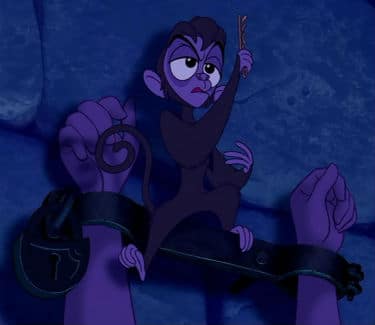
Photo: Disney
Thirdly, be careful who you trust. The Sultan trusted Jafar (because, of course, you can’t judge a book by its cover!), and it backfires horribly on him. Jasmine trusts Aladdin pretty quickly (but he saved her live, so I suppose that makes it okay). My point is, she lucked out. He could have been a Gaston.
Fourthly, no one wants to be a slave. Freedom is something that all people crave, as is the chance to make their lives better. Whether we’re a blue genie or a princess, everyone wants the chance to make their own choices about life and have those choices recognized.
Fifthly, sometimes we are more than what we seem. Everyone underestimated Aladdin, even Aladdin because he seemed like an average, everyday thief. Actually, he was a “diamond in the rough,” and was able to do things no one else could. Basically, don’t underestimate either yourself or those around you.
DOES IT HOLD UP?
This movie is one that still looks and sounds great today. It’s a grand adventure on an epic scale that makes you laugh and cry. In the grand tradition of Disney Renaissance pieces, it’s a solid and fun piece. If you haven’t seen this is a while, it might be time to brush off this classic and let it take you to a whole new world.
For next week: The Lion King
If you enjoyed this post and the others in the Revisiting Disney series, and have found yourself wishing that you could find them all in one convenient and bound book with eight extra essays, there is an option for you! Check out A Journey Through Disney: My Look Back Through Disney Canon, now available on Amazon as both a Kindle book ($4.99) and a paperback ($11.99).
OTHER SOURCES:
https://thewaltdisneycompany.com/about-disney/disney-history
http://www.imdb.com
http://studioservices.go.com/disneystudios/history.html
http://www.thepeoplehistory.com/1992.html
http://www.kidzworld.com/article/4255-1990s-timeline
Bailey, Adrian. Walt Disney’s World of Fantasy. Everest House Publishers. New York, New York. 1982.
Finch, Christopher. The Art of Walt Disney: From Mickey Mouse to the Magic Kingdom. Harry N. Abrams, Inc. New York, New York. 1975.
Johnston, Ollie and Frank Thomas. The Disney Villain. Hyperion. New York, New York. 1993.
Sale, Roger. Fairy Tales and After: From Snow White to E.B. White. Harvard University Press. Cambridge, MA, 1978.
Tatar, Maria. The Annotated Classic Fairy Tales. W.W. Norton and Company. New York and London, 2002.
Thomas, Bob. Disney’s Art of Animation From Mickey Mouse to Hercules. Hyperion. New York, New York. 1992.
Wright, Gordon. The Ordeal of Total War: 1939-1945. Harper Torchbooks, Harper & Row. New York, Hagerstown, San Francisco, and London, 1968.
ARE YOU A ROMANCE FAN? FOLLOW THE SILVER PETTICOAT REVIEW:
 Our romance-themed entertainment site is on a mission to help you find the best period dramas, romance movies, TV shows, and books. Other topics include Jane Austen, Classic Hollywood, TV Couples, Fairy Tales, Romantic Living, Romanticism, and more. We’re damsels not in distress fighting for the all-new optimistic Romantic Revolution. Join us and subscribe. For more information, see our About, Old-Fashioned Romance 101, Modern Romanticism 101, and Romantic Living 101.
Our romance-themed entertainment site is on a mission to help you find the best period dramas, romance movies, TV shows, and books. Other topics include Jane Austen, Classic Hollywood, TV Couples, Fairy Tales, Romantic Living, Romanticism, and more. We’re damsels not in distress fighting for the all-new optimistic Romantic Revolution. Join us and subscribe. For more information, see our About, Old-Fashioned Romance 101, Modern Romanticism 101, and Romantic Living 101.

Lovely.. A whole new world is one of my favourite songs from Disney moveis.. And those shots of Alladin and Jasmine on the magic carpet ride are dreamy. Very interesting post Bailey.
Thanks Rhea! I always find that I learn so much when writing these, and I was really excited about those magic carpet shots 🙂